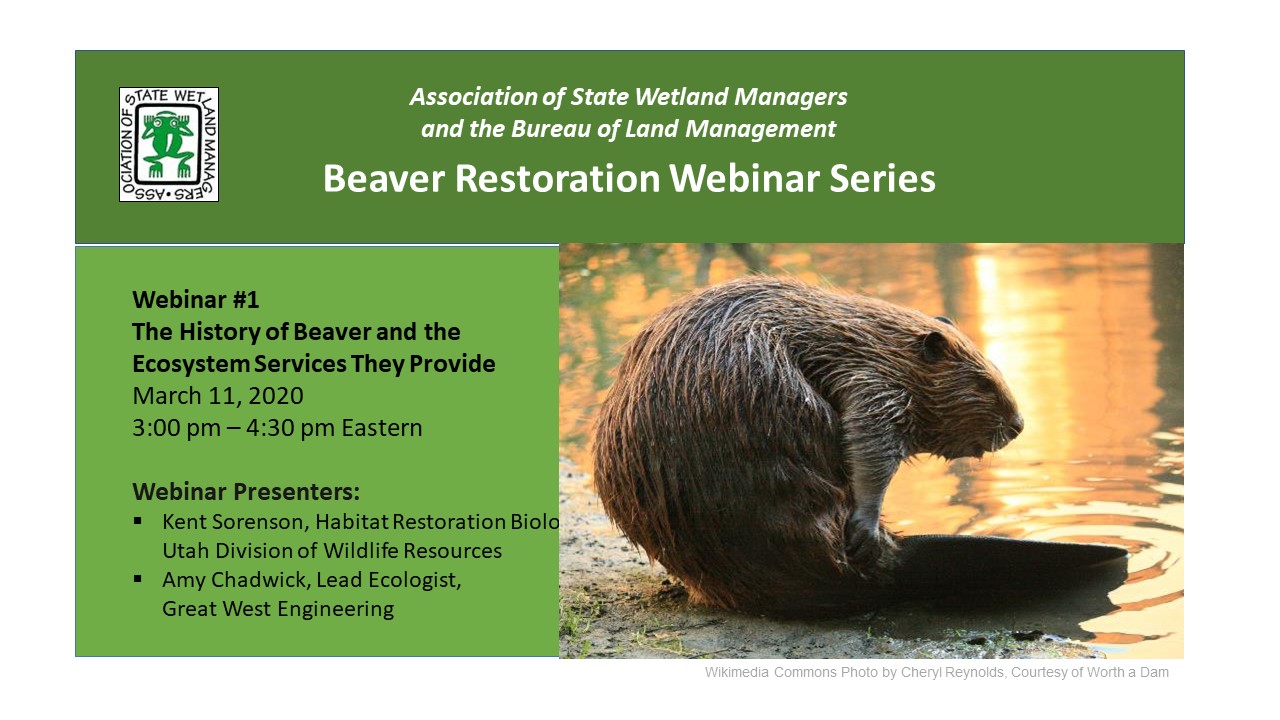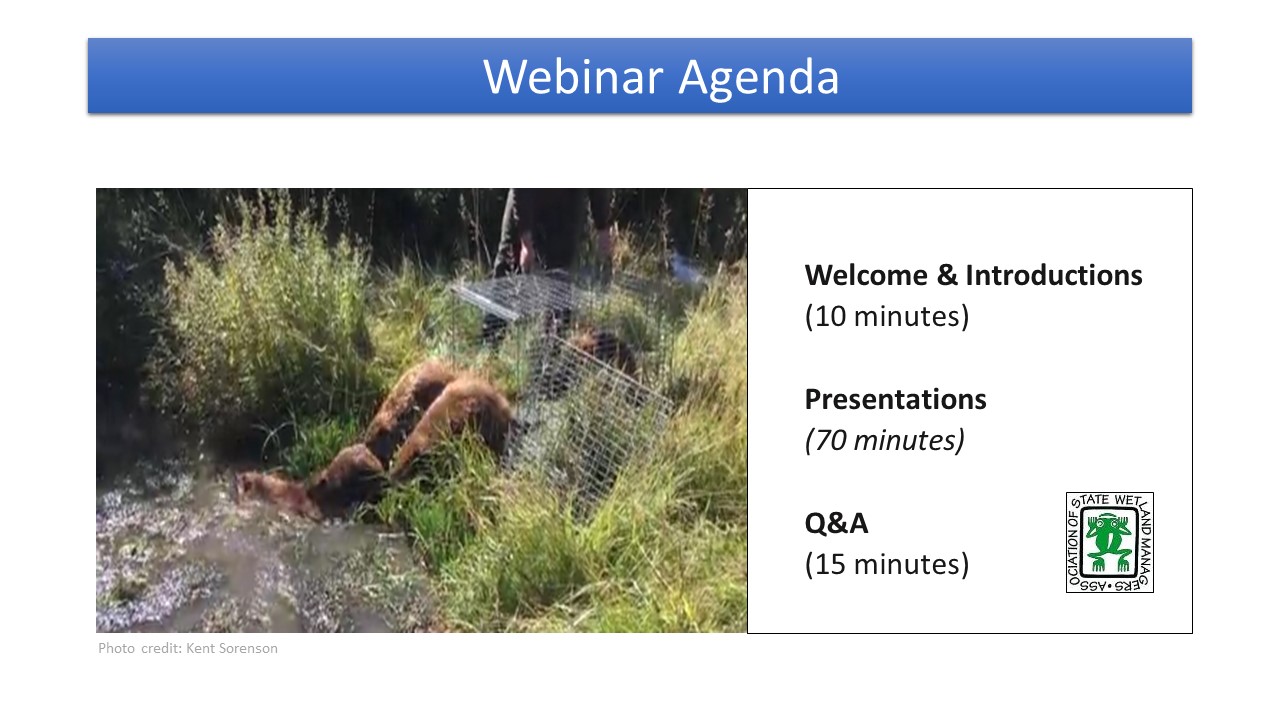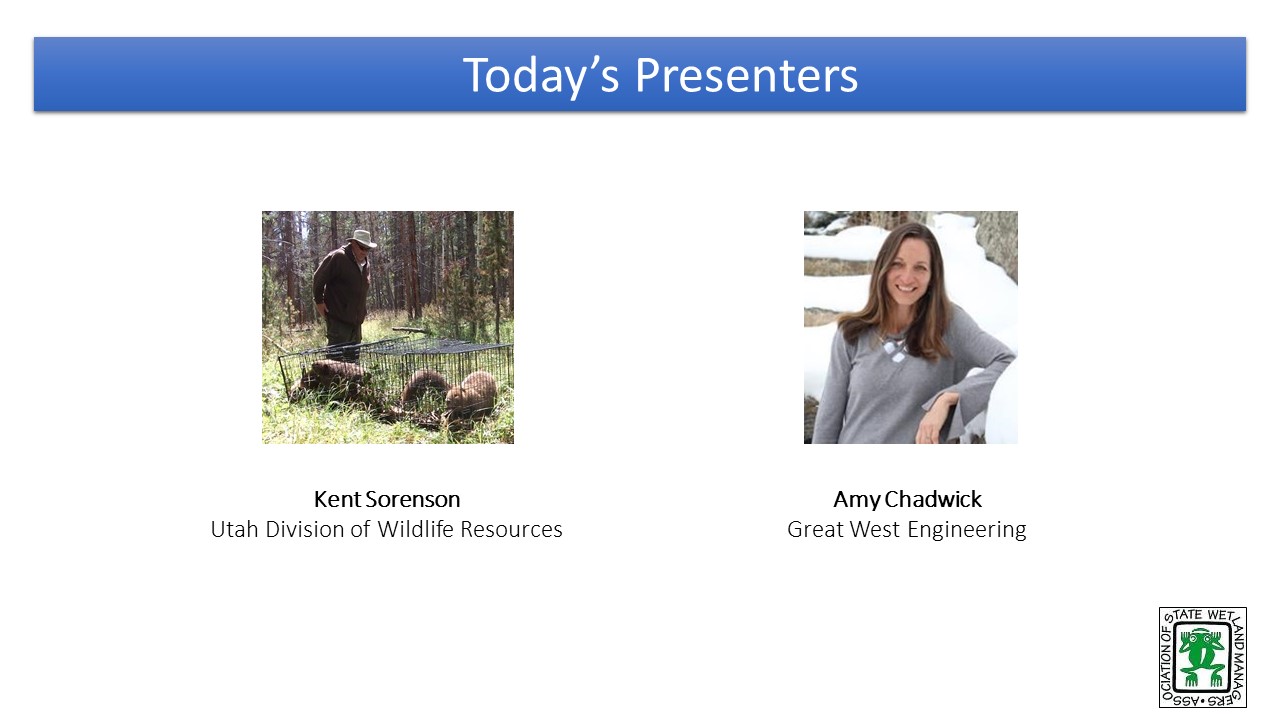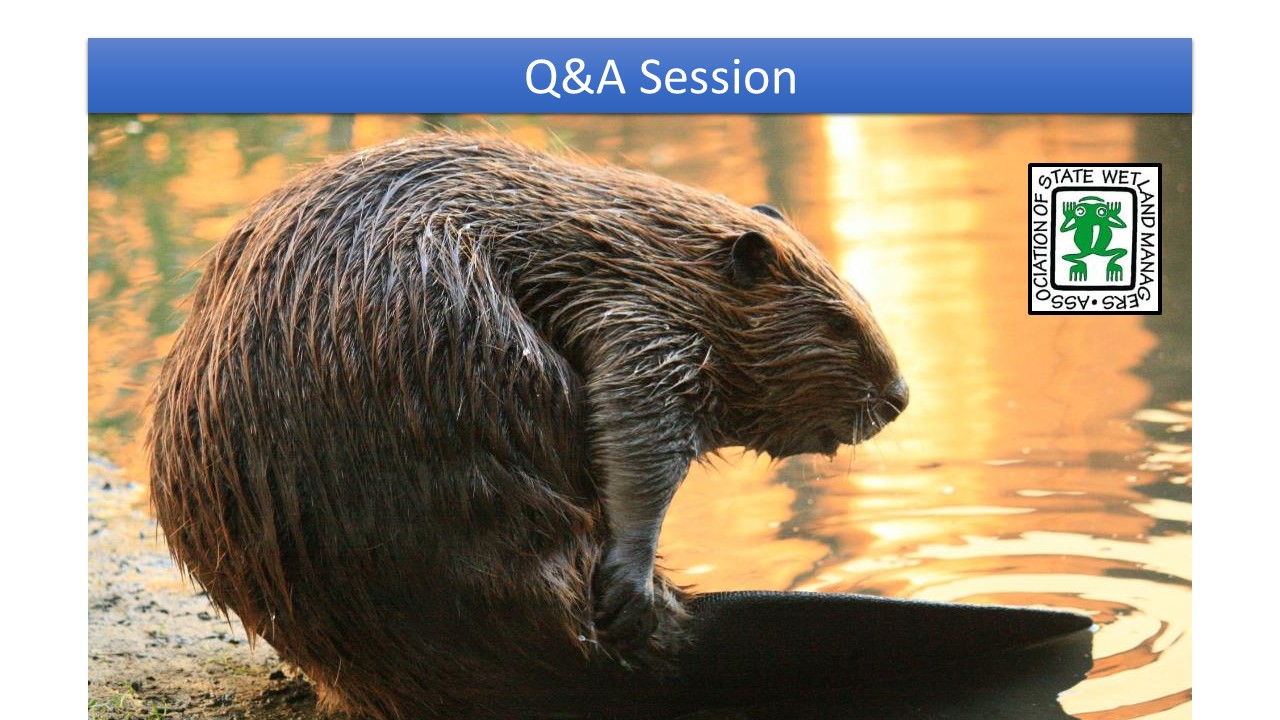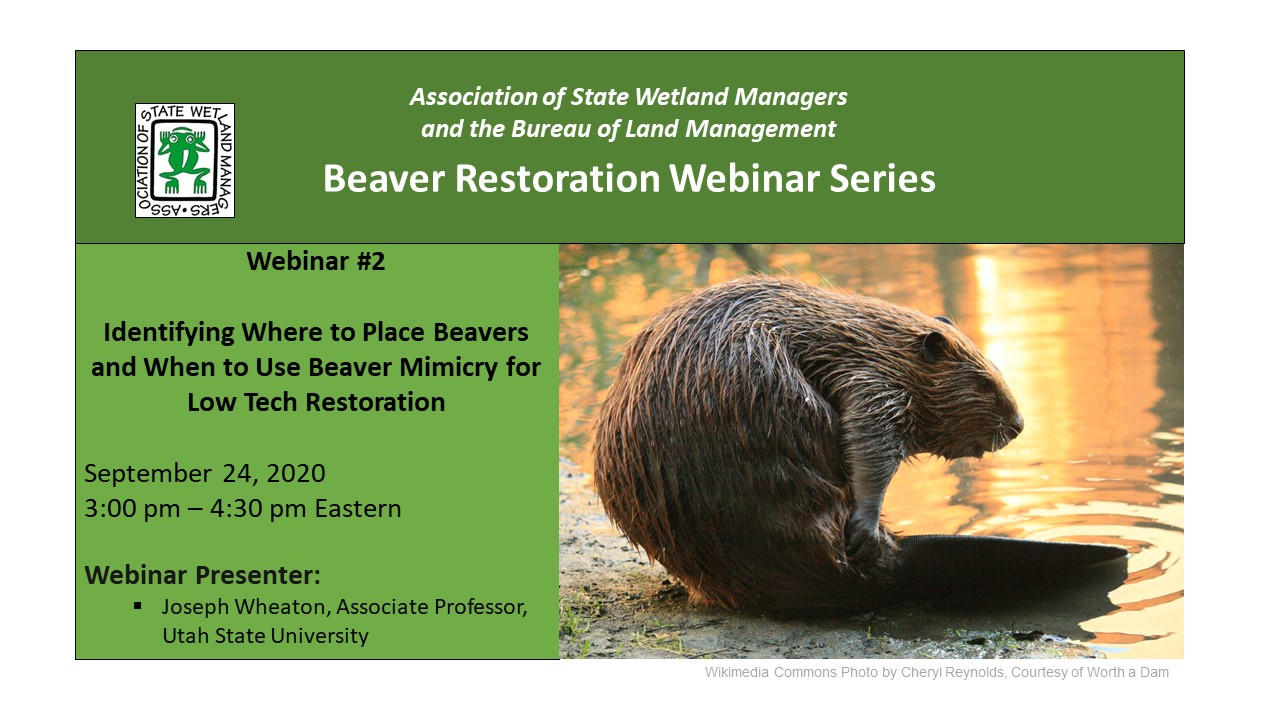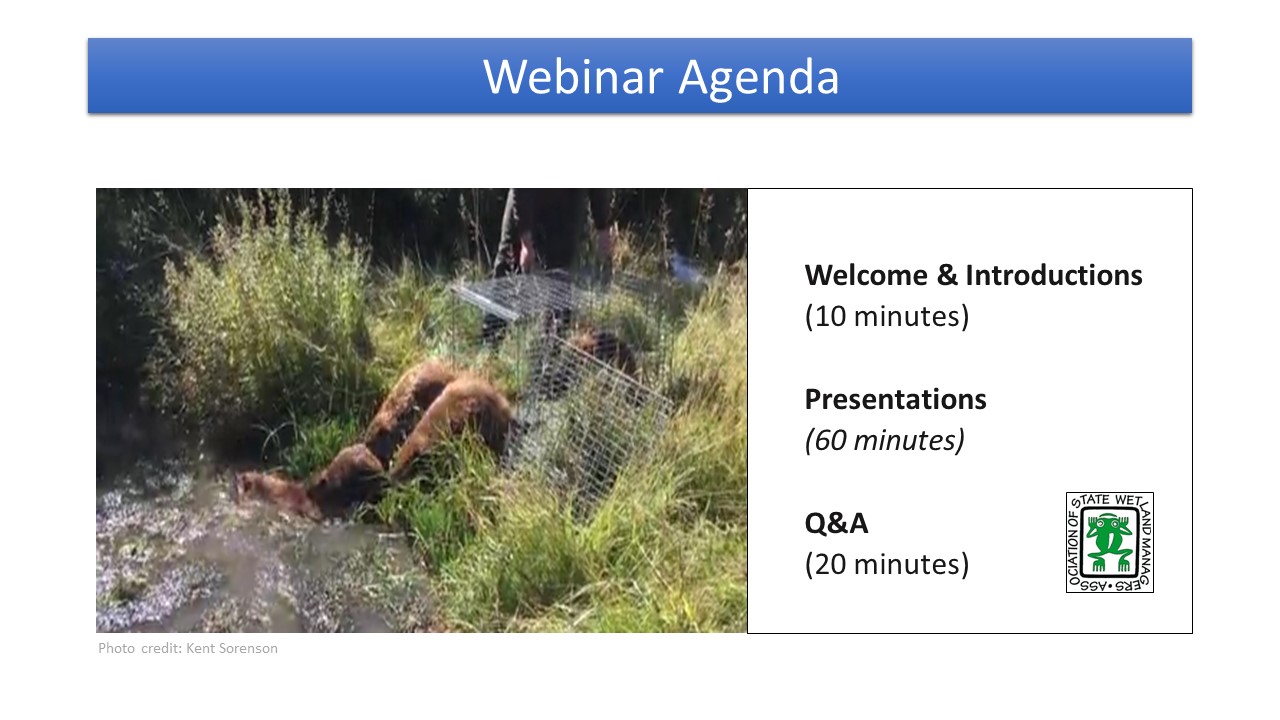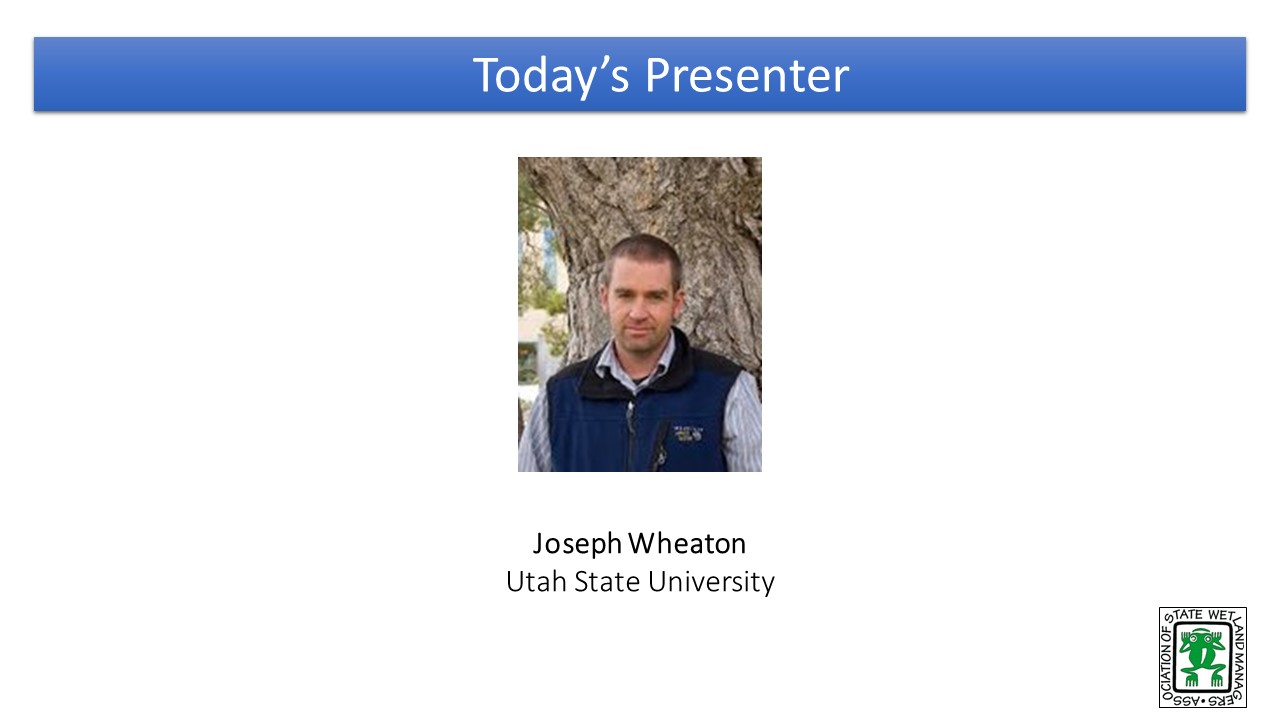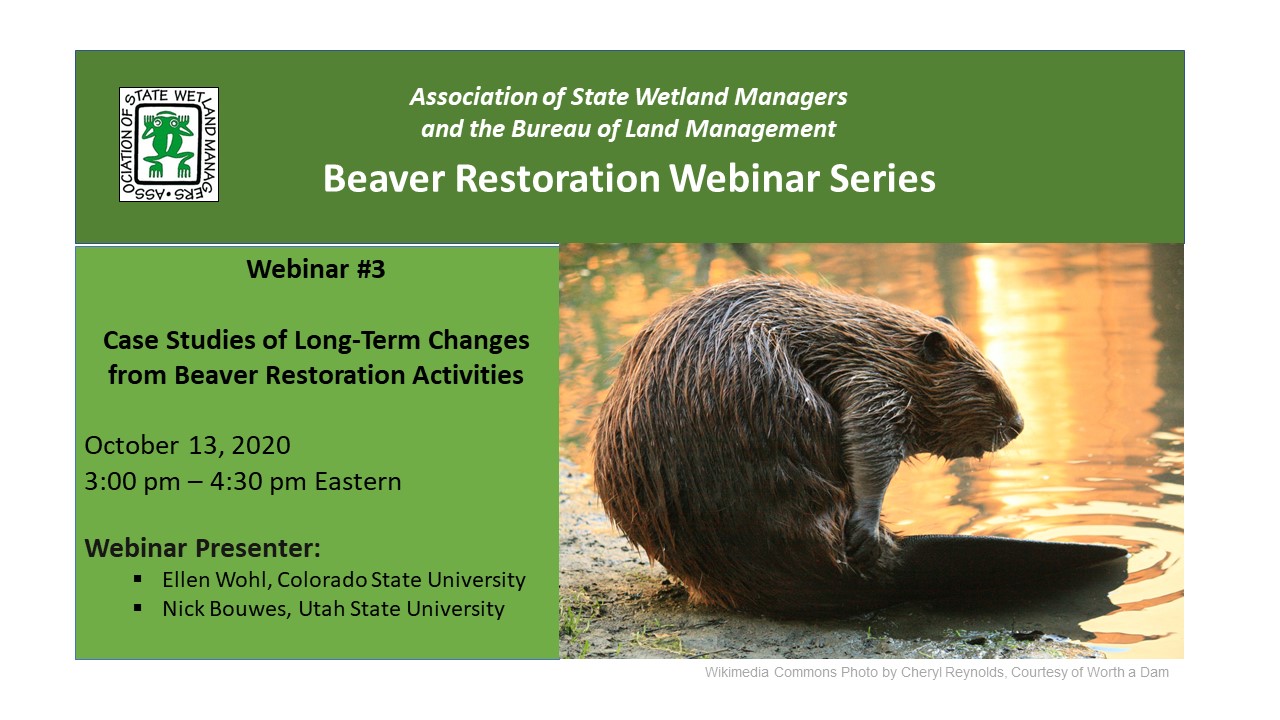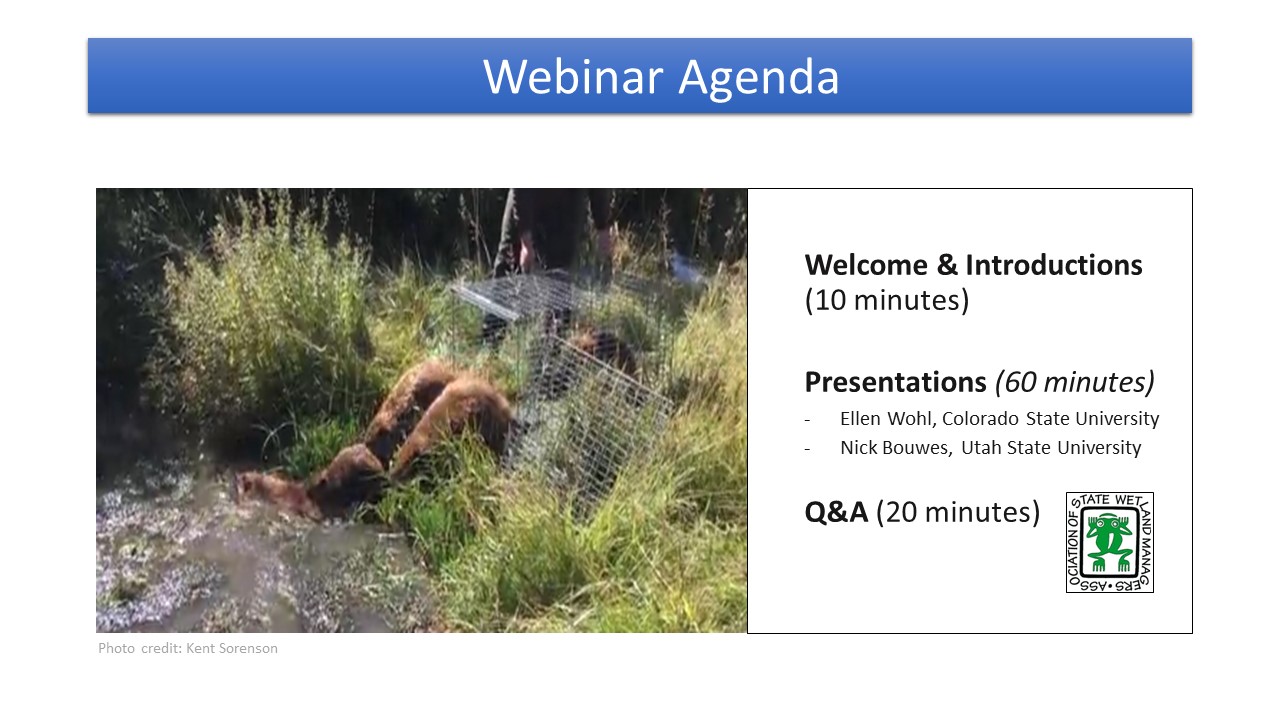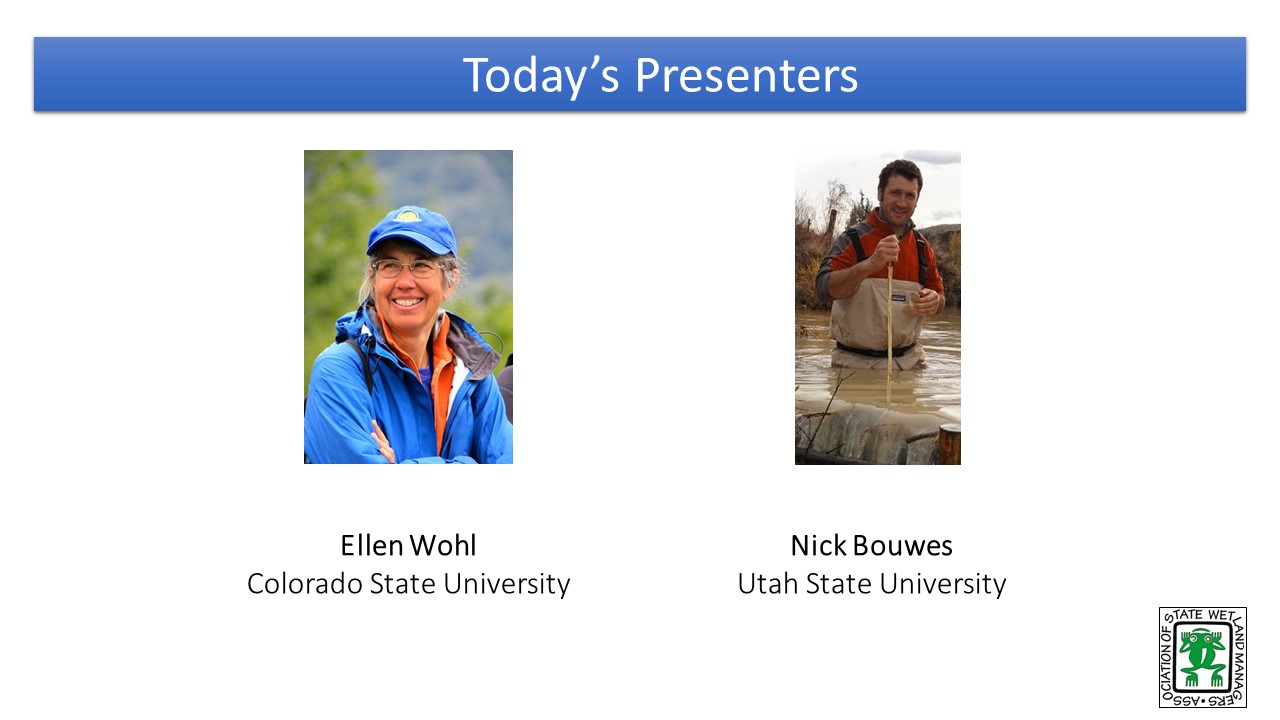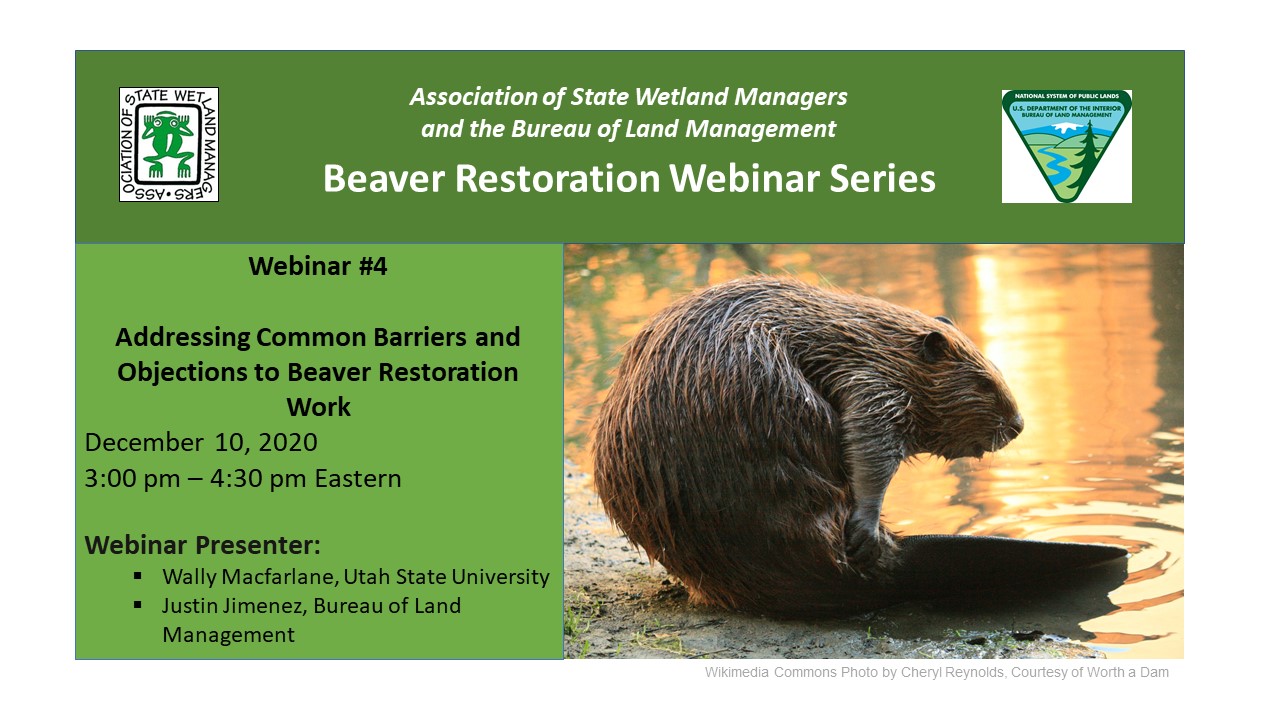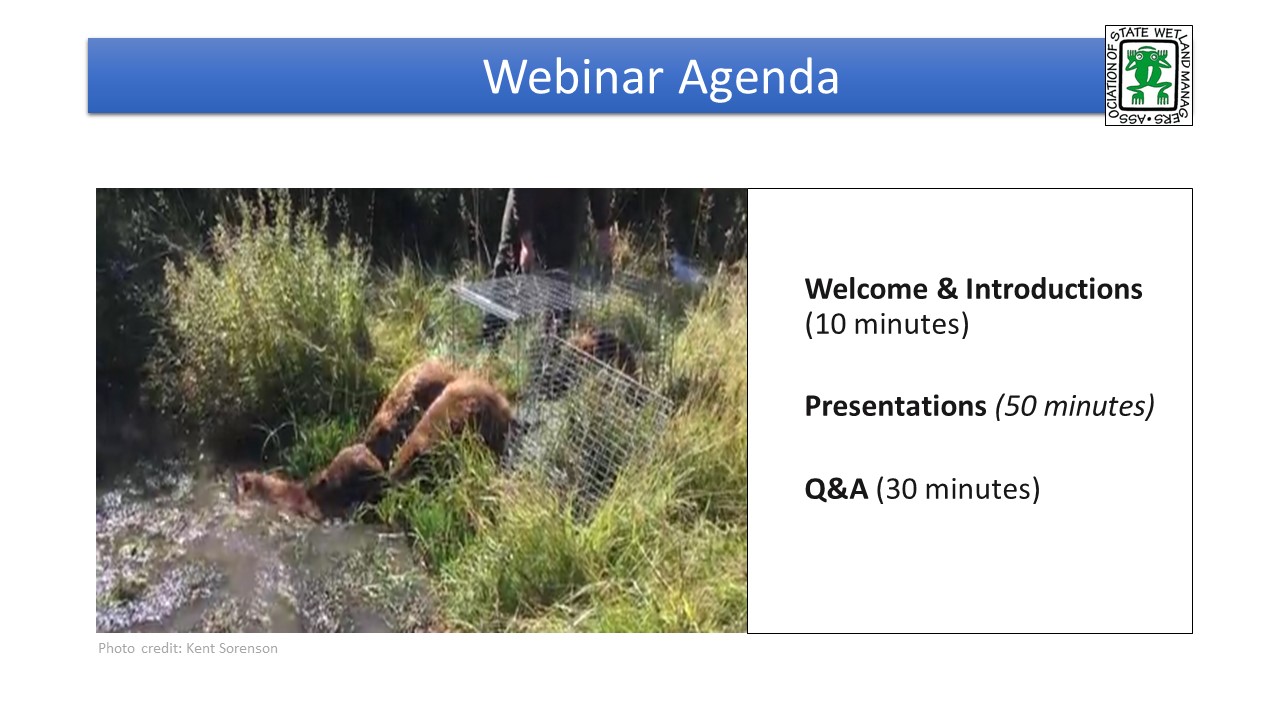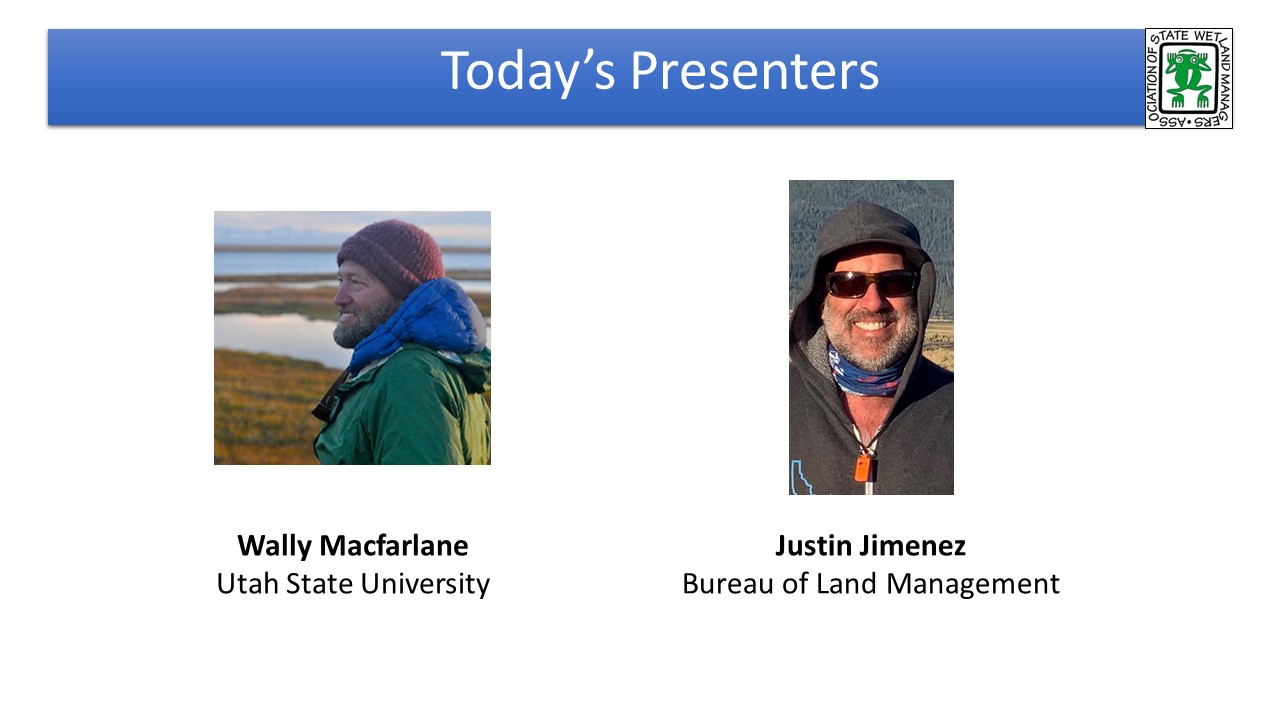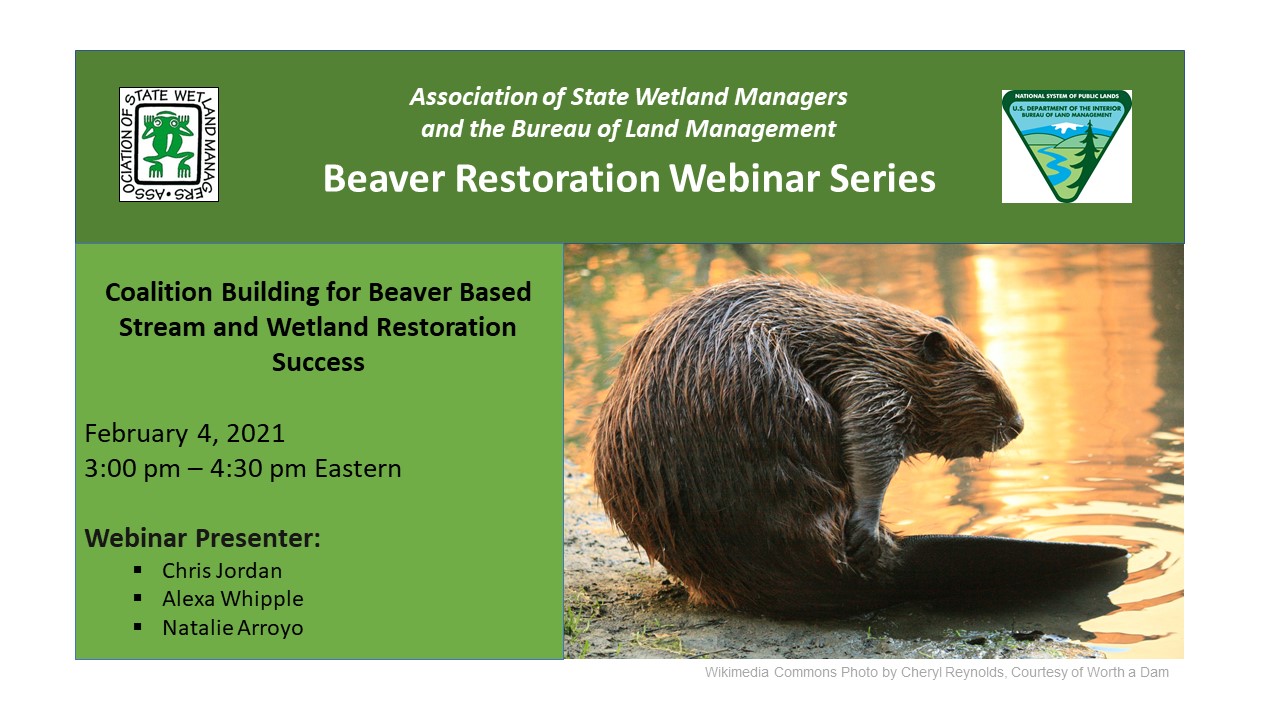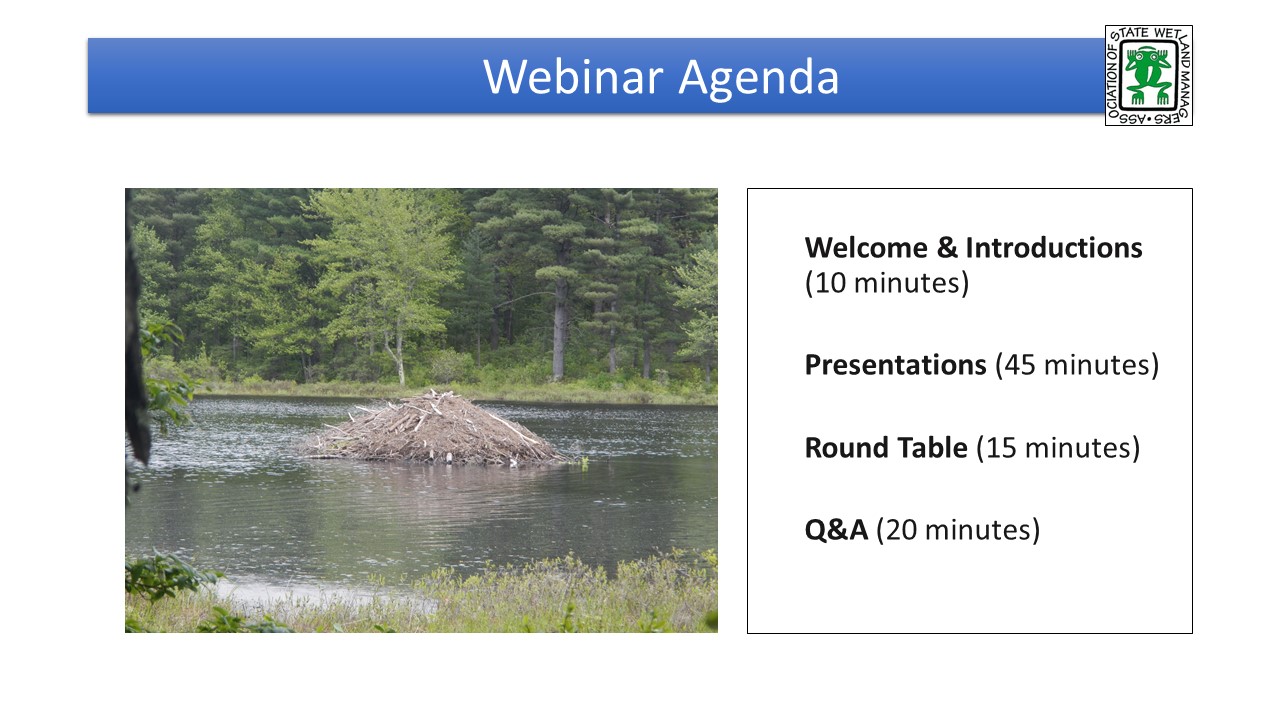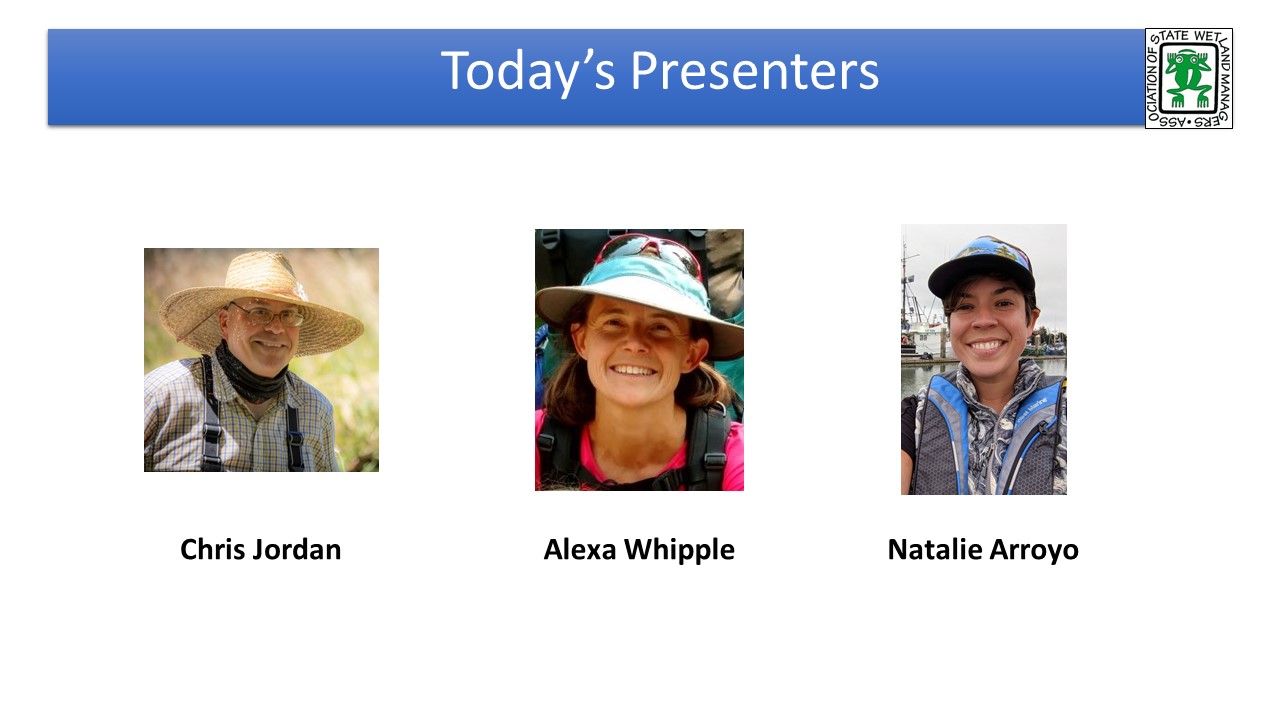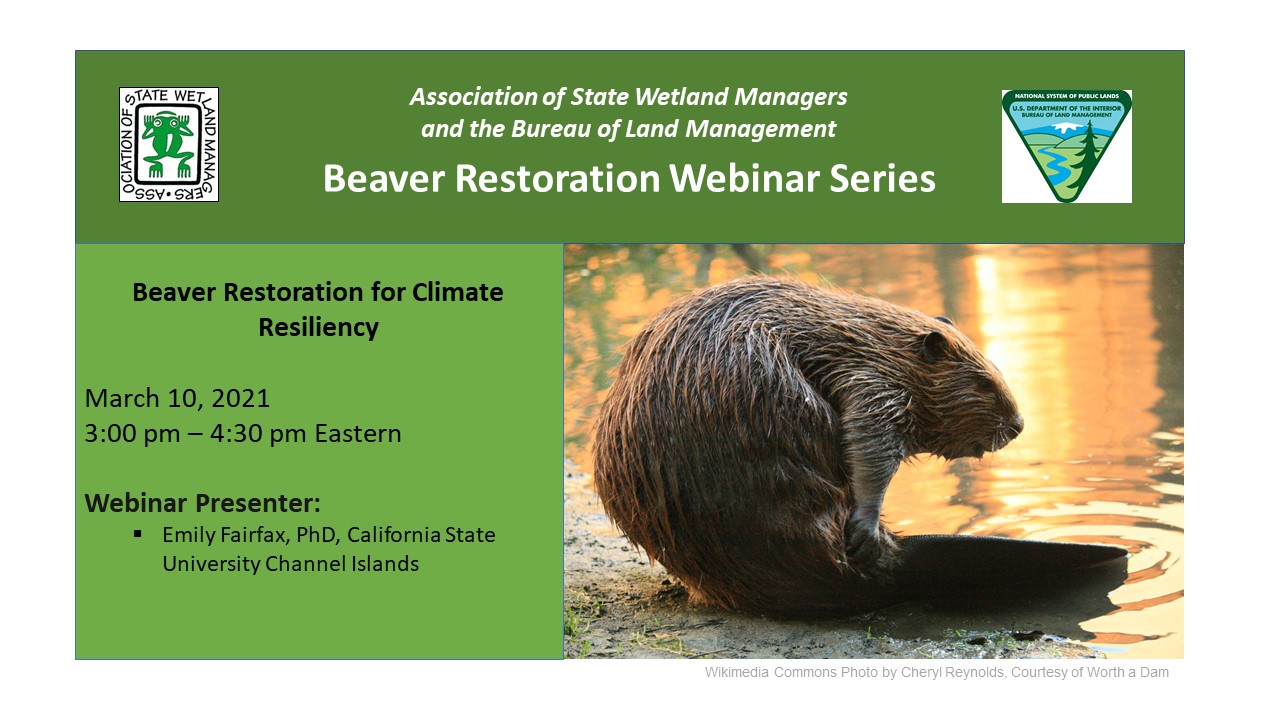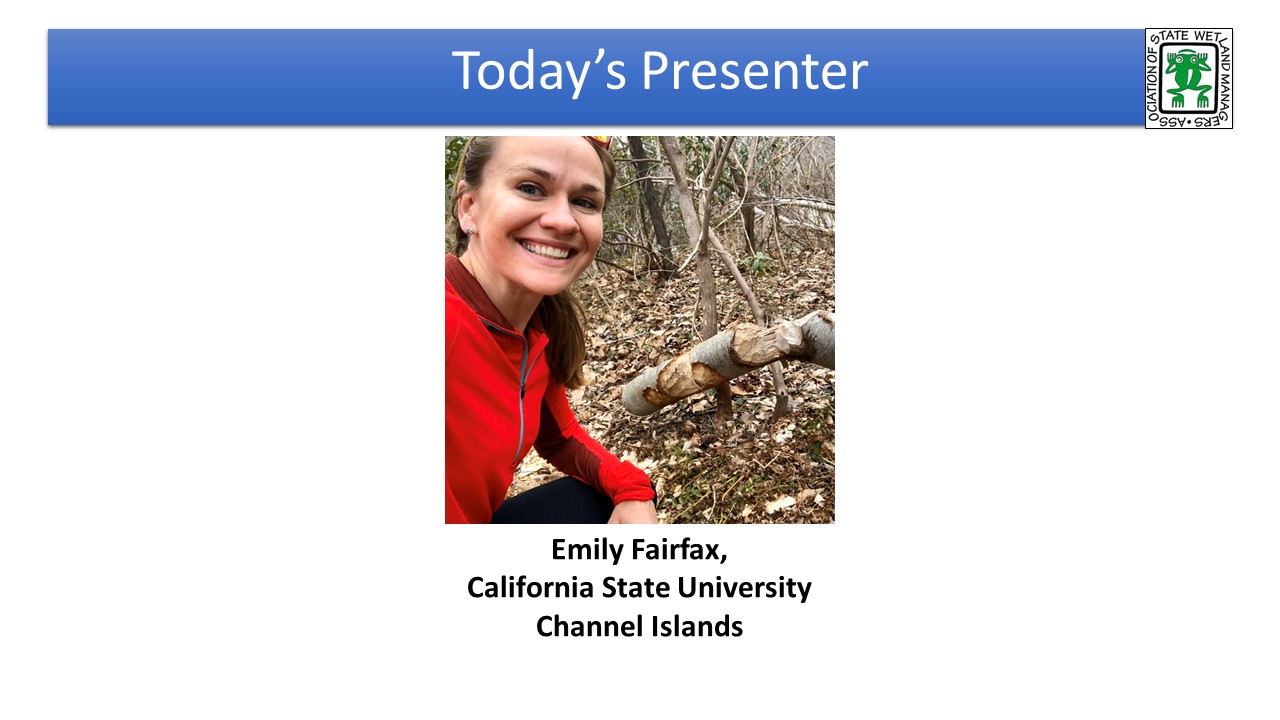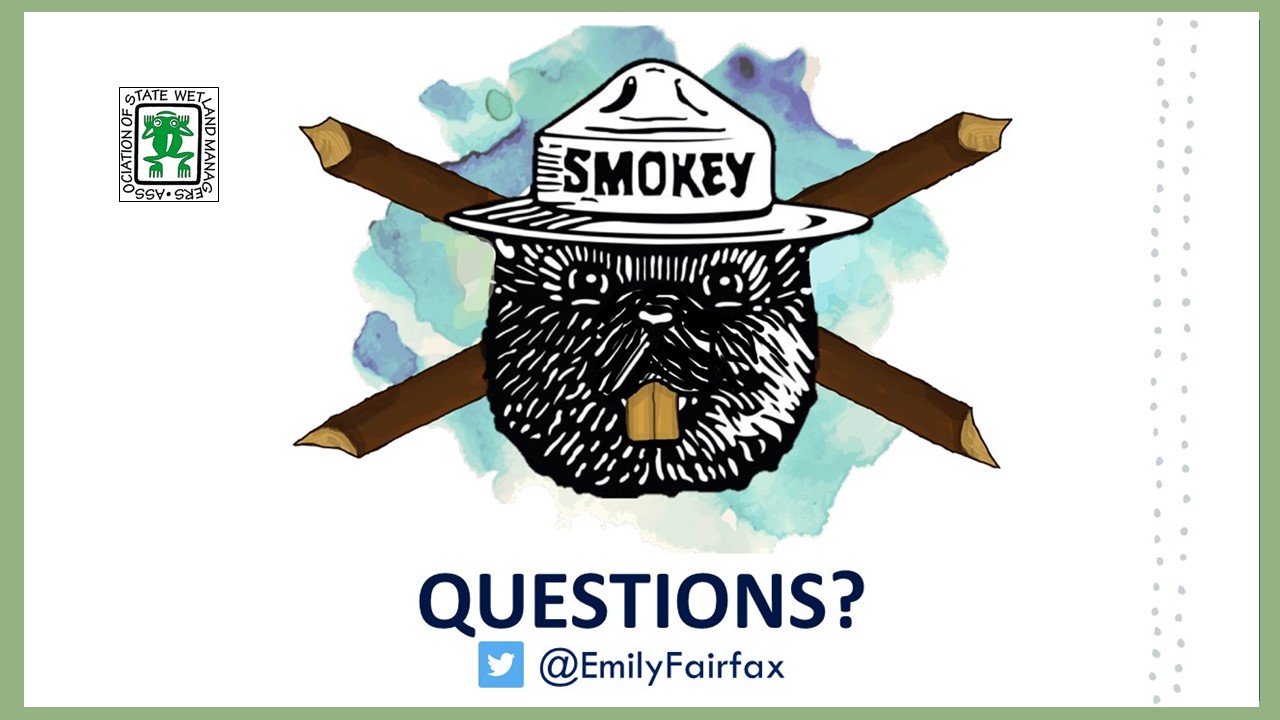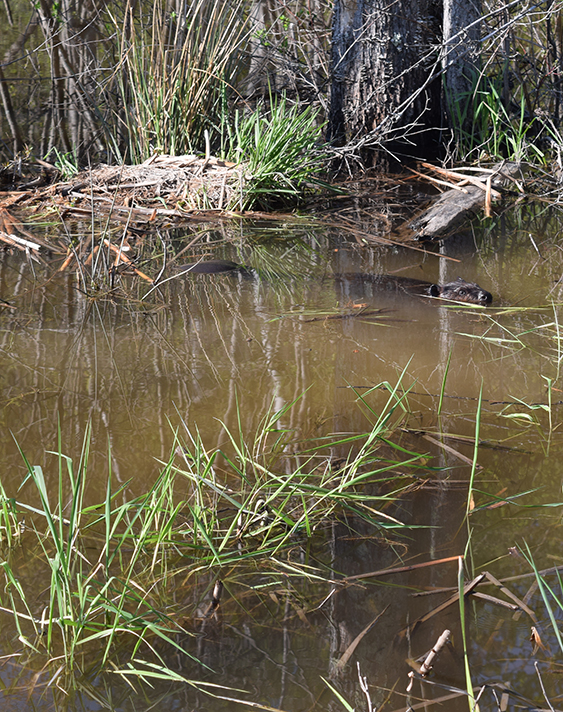 The National Association of Wetland Managers (NAWM) and the Bureau of Land Management (BLM) collaborated to develop a series of webinars introducing the topic of restoration of aquatic ecosystems through the reintroduction of beavers, the use of beaver dam analogues (BDAs) or restoration designed to attract beavers to an area to contribute to changing hydrology and restoring ecosystem services. This webinar series was developed with guidance from a national workgroup of beaver restoration experts with presentations provided by practitioners, managers and researchers working in the field. The webinar series covers the basics of beaver restoration and continues through implementation challenges and ways to encourage beaver restoration projects.
The National Association of Wetland Managers (NAWM) and the Bureau of Land Management (BLM) collaborated to develop a series of webinars introducing the topic of restoration of aquatic ecosystems through the reintroduction of beavers, the use of beaver dam analogues (BDAs) or restoration designed to attract beavers to an area to contribute to changing hydrology and restoring ecosystem services. This webinar series was developed with guidance from a national workgroup of beaver restoration experts with presentations provided by practitioners, managers and researchers working in the field. The webinar series covers the basics of beaver restoration and continues through implementation challenges and ways to encourage beaver restoration projects.
List of Webinars in the Training Series (6 modules)
Module 01: The History of Beaver and the Ecosystem Services They Provide
Module 03: Case Studies of Long-term Changes from Beaver Restoration Activities
Module 04: Addressing Common Barriers and Objections to Beaver Restoration Work
Module 05: Coalition Building for Beaver Based Stream and Wetland Restoration Success
Module 06: Beaver Restoration for Climate Resiliency
Optional Module Quiz and Certificate of Completion for Use in Applying for Continuing Education Credits (CEUs)
Each online module in the Beaver-Related Restoration Training Series is accompanied by an optional knowledge assessment quiz available through ClassMarker. The quiz assesses understanding of the key take-away points of the training.
Please Note, Scheduled Maintenance: ClassMarker will be doing scheduled maintenance on Saturday, December 20 at 6:00 p.m. ET for 5 to 6 hours. During this time, you will not be able to get certificates for webinars or online trainings.
NAWM Members - as a benefit of membership, you will have the opportunity to download a free Certificate of Completion for each module quiz that you pass. Log In to the membership portal to access the learning modules and quizzes.
Non-Members - you have free access to view the learning modules. There is a $25.00 USD fee per module to take the online quiz towards achieving a Certificate of Attendance. Secure payment is made through PayPal, either with a PayPal account or with the guest option, using a credit card.
![]()
Module 1: The History of Beaver and the Ecosystem Services They Provide
PRESENTERS
- NAWM Introduction [PowerPoint Presentation]
- Kent Sorenson, Habitat Restoration Biologist, Utah Division of Wildlife Resources [PowerPoint Presentation]
- Amy Chadwick, Lead Ecologist, Great West Engineering [PowerPoint Presentation]
ABSTRACT
This first training in the National Association of Wetland Managers (NAWM) and Bureau of Land Management (BLM) co-hosted six-part training series on beaver restoration provided the historical background of beaver on the land and the impacts from loss of beaver (through various hunting, trapping and removal activities) in terms of hydrology. This training shares what valley bottoms can be with restoration of hydrology and the role that beavers and beaver dam analogs (BDAs) can play in that restoration. The training explains the Stage Zero concept and unpack the challenges created by common practices that have been restoring streams to their first point of failure.
LEARNING OBJECTIVES
As a result of participating in this training, participants will better understand:
- The history of beaver on the land
- Impacts from loss of beaver in terms of hydrology
- What valley bottoms can be (and that many don’t know)
- The Stage Zero concept
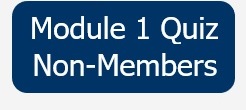 To Take the Quiz and Receive a Certificate of Completion for this Module
To Take the Quiz and Receive a Certificate of Completion for this ModuleIf you are a current NAWM Member, Log In here. If you are not an NAWM Member, there is a $25.00 USD fee per module quiz. To proceed with payment and access the module quiz, select the Module 1 Quiz button to transfer to the ClassMarker system. Upon successful completion of the module quiz, you will be eligible for a Certificate of Completion for 1.5 hours of training.
![]()
Module 2: Identifying Where to Place Beavers and When to Use Beaver Mimicry for Low Tech Restoration in the Arid West
PRESENTER
- NAWM Introduction [PowerPoint Presentation]
- Joe Wheaton, Associate Professor, Utah State University [PowerPoint Presentation]
ABSTRACT
This second training in the NAWM-BLM Beaver Restoration Training Series focuses on making decisions about where beaver restoration and/or the use of beaver dam analogs (BDA) can have the greatest positive and least negative impacts. Understanding that beaver restoration is not well-suited for all contexts and purposes, this training discusses risk assessment and introduces participants to the primary elements required to assess the efficacy of beaver projects for specific watersheds and sites. The training shares how data can be used to make decisions about different kinds of flow devices and when beaver mimicry/BDAs make more sense. It also includes a demonstration of Utah State University’s Beaver Restoration Assessment Tool (BRAT), a model that helps planners assess key parameters (such as human interaction, hydrological setting, etc.) essential to beaver work. The training ends with discussion about the importance of post-construction monitoring.
LEARNING OBJECTIVES
As a result of participating in this training, participants will better understand:
- How to complete a risk assessment
- Many assumptions are made w/o data
- The importance of monitoring (esp. where some may require large post-construction monitoring)
- Information about different kinds of flow devices
- When beaver mimicry/BDAs make more sense and environmental responses to mimicry work
- Considering beaver in urban settings
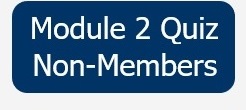 To Take the Quiz and Receive a Certificate of Completion for this Module
To Take the Quiz and Receive a Certificate of Completion for this ModuleIf you are a current NAWM Member, Log In here. If you are not an NAWM Member, there is a $25.00 USD fee per module quiz. To proceed with payment and access the module quiz, select the Module 1 Quiz button to transfer to the ClassMarker system. Upon successful completion of the module quiz, you will be eligible for a Certificate of Completion for 1.5 hours of training.
![]()
Module 3: Case Studies of Long-term Changes from Beaver Restoration Activities
PRESENTERS
- NAWM Introduction [PowerPoint Presentation]
- Ellen Wohl, Colorado State University [PowerPoint Presentation]
- Nick Bouwes, Utah State University [PowerPoint Presentation]
ABSTRACT
This third training in the NAWM-BLM Beaver Restoration Training Series focuses on the long-term changes in riverscapes that result from beaver restoration. Where intense stream restoration is needed, people are identifying low-tech process-based methods that combine the management of grazing, beaver and other approaches that engage processes to create self-sustaining solutions. Understanding the dynamic nature of these systems is important to understanding where and how they can be useful. This training share case studies of work completed, focusing on the use of beaver to restore riverscapes.
LEARNING OBJECTIVES
As a result of participating in this training, participants will better understand the following common barriers to beaver/BDA work:
- Taking water from downstream
- Potential for Infrastructure Damage
- Minimum Habitat Requirements (currently no clear requirements)
- Beaver as a nuisance species (issues with lethal management); the fight for non-lethal management
- Beaver relocation BMPs
- Insights on how to share benefits info with ag producers
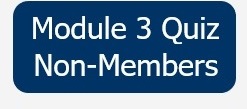 To Take the Quiz and Receive a Certificate of Completion for this Module
To Take the Quiz and Receive a Certificate of Completion for this ModuleIf you are a current NAWM Member, Log In here. If you are not an NAWM Member, there is a $25.00 USD fee per module quiz. To proceed with payment and access the module quiz, select the Module 1 Quiz button to transfer to the ClassMarker system. Upon successful completion of the module quiz, you will be eligible for a Certificate of Completion for 1.5 hours of training.
![]()
Module 4: Addressing Common Barriers and Objections to Beaver Restoration Work
PRESENTERS
- NAWM Introduction [PowerPoint Presentation]
- Wally MacFarlane, Utah State University [PowerPoint Presentation]
- Justin Jimenez, Bureau of Land Management [PowerPoint Presentation]
ABSTRACT
This fourth module in the NAWM-BLM Beaver Restoration Training Series focuses on common barriers to beaver restoration and beaver dam analog (BDA) work and when/how these barriers can be overcome. Common local landowner concerns include the taking of water from downstream water users, the potential for infrastructure damage, and a general intolerance for dam building activities. Common barriers to project success include long delays associated with the NEPA process and inability to sustain strong, diverse and long-lasting project partners. This training provides case studies from Utah and Idaho and insights on best management practices for successful beaver restoration and BDA work.
LEARNING OBJECTIVES
As a result of participating in this training, participants will better understand common barriers to beaver/BDA work:
- Taking water from downstream
- Potential for Infrastructure Damage
- Minimum Habitat Requirements (currently no clear req’s)
- Beaver as a nuisance species (issues with lethal management); the fight for non-lethal management
- Beaver relocation BMPs
- Insights on how to share benefits info with ag producers
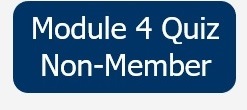 To Take the Quiz and Receive a Certificate of Completion for this Module
To Take the Quiz and Receive a Certificate of Completion for this ModuleIf you are a current NAWM Member, Log In here. If you are not an NAWM Member, there is a $25.00 USD fee per module quiz. To proceed with payment and access the module quiz, select the Module 1 Quiz button to transfer to the ClassMarker system. Upon successful completion of the module quiz, you will be eligible for a Certificate of Completion for 1.5 hours of training.
![]()
Module 5: Coalition Building for Beaver Based Stream and Wetland Restoration Success
PRESENTERS
- NAWM Introduction [PowerPoint Presentation]
- Chris Jordan, NOAA's Northwest Fisheries Science Center[PowerPoint Presentation]
- Alexa Whipple, Methow Beaver Project [PowerPoint Presentation]
- Natalie Arroyo [PowerPoint Presentation]
ABSTRACT
This fifth training in the NAWM-BLM Beaver Restoration Training Series focuses on how coalition building is essential to advancing the practice of process-based stream and floodplain restoration by helping the regulatory environment be responsive to the evolving understanding around functioning, intact riverscapes. Intentional and inclusive outreach efforts and creative partnerships are critical to achieving positive restoration outcomes. Restoring floodplains based on mimicking beaver dam inundated wetlands and their inherent complexity is a paradigm shift for the stream and wetland restoration community. Practitioners are eager to engage and the science community has jumped in. However, the regulatory community has not seen the same degree of development. Only through inclusive coalitions building will it be possible to develop commonly held values around functioning, process-based, vibrant ecosystems that support the natural and human ecologies essential for resilient ecosystems.
LEARNING OBJECTIVES
As a result of participating in this training, participants will better understand:
- The need to minimize conflict over the management of beavers
- Considerations for getting through the policy gauntlet
- Permitting and water rights considerations for beaver mimicry projects in various states
- Ideas around overcoming institutional ruts
- The need to develop effective partnerships
- Potential opportunities to work with tribes
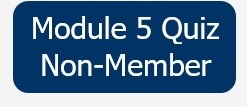 To Take the Quiz and Receive a Certificate of Completion for this Module
To Take the Quiz and Receive a Certificate of Completion for this ModuleIf you are a current NAWM Member, Log In here. If you are not an NAWM Member, there is a $25.00 USD fee per module quiz. To proceed with payment and access the module quiz, select the Module 1 Quiz button to transfer to the ClassMarker system. Upon successful completion of the module quiz, you will be eligible for a Certificate of Completion for 1.5 hours of training.
![]()
Module 6: Beaver Restoration for Climate Resiliency
PRESENTER
- NAWM Introduction [PowerPoint Presentation]
- Emily Fairfax, California State University Channel Islands [PowerPoint Presentation]
ABSTRACT
The sixth training in the NAWM-BLM Beaver Restoration Training Series focuses on the role that beaver restoration can play in building climate resiliency to drought and wildfires. Beaver dams are gaining popularity as a low‐tech, low‐cost strategy to build climate resiliency at the landscape scale. They slow and store water that can be accessed by riparian vegetation during dry periods, effectively protecting riparian ecosystems from droughts. The training shares research indicating that beavers are able to create and maintain wetlands resistant to both seasonal and multiyear droughts and that this landscape wetting and drought buffering goes on to reduce or prevent burning in wildfire. The training explores the concept that perhaps instead of relying solely on human engineering and management to create and maintain fire‐resistant landscape patches, communities could benefit from beaver’s ecosystem engineering to achieve the same goals at a lower cost.
LEARNING OBJECTIVES
As a result of participating in this training participants will better understand how the presence of beavers:
- Are an integral part of natural climate adaptation and mitigation
- Can be located for consideration in climate resilience planning using easy-to-access tools
- Are crucial components of keeping landscapes healthy during floods, droughts and wildfires
- Have been found to increase resilience despite varying climates, landcover and antecedent conditions
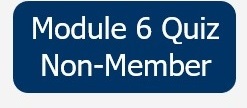 To Take the Quiz and Receive a Certificate of Completion for this Module
To Take the Quiz and Receive a Certificate of Completion for this ModuleIf you are a current NAWM Member, Log In here. If you are not an NAWM Member, there is a $25.00 USD fee per module quiz. To proceed with payment and access the module quiz, select the Module 1 Quiz button to transfer to the ClassMarker system. Upon successful completion of the module quiz, you will be eligible for a Certificate of Completion for 1.5 hours of training.
You will need to develop username and password in ClassMarker for each online quiz. Once you click on the quiz link, you will be prompted again to provide your name and email address. This will be used to process your certificate.
Participants who both view the module presentation and complete the module quiz are eligible for an NAWM Certificate of Completion for 1.5 hours of training.
To receive your certificate, you must BOTH:
- Certify that you completed viewing the Beaver-Related Restoration training module video presentation. Answering “no” will result in no certificate being issued.
- Complete all knowledge quiz questions with the required minimum of eighty percent (80%) of the questions answered correctly. You will be provided two attempts to take the quiz for the module. If at the end of your second attempt you have not been able to achieve a minimum score of eighty percent, you will not be eligible to receive a certificate.
You will be prompted to download your Certificate of Completion from ClassMarker after you complete the quiz. Once you download your certificate, you can then submit the certificate to the accrediting organization of your choice to potentially receive continuing education units/credits.
If you did not answer at least 80% of the quiz questions correct on your first attempt, you can re-take the test one more time (total of two attempts). Return to the NAWM module page and START the test again (vs Resume).
You must use the same email, username and password for the second quiz attempt for this same module. ClassMarker will recognize your email for the specific training module and will not charge you for the second attempt. If you do not achieve at least 80% of the quiz questions correct on your second attempt, you will not be eligible to receive a Certificate of Completion.
We encourage you to go to the NAWM.org website and become a member so that you can receive Certificates of Completion (trainings) and Certificates of Participation (live webinars) at no charge for the next 12 months.
If you have any questions, please contact Laura Burchill at laura@nawm.org or contact the NAWM office at (207) 892-3399.
![]()

